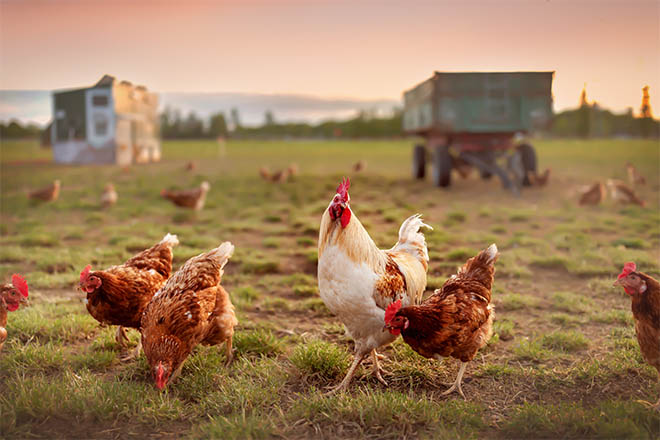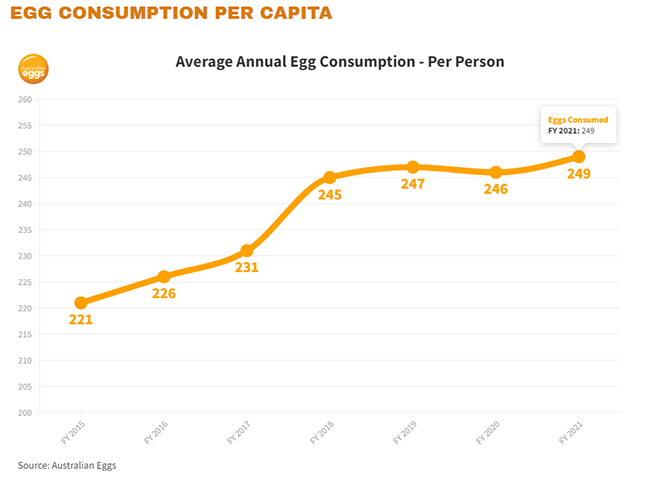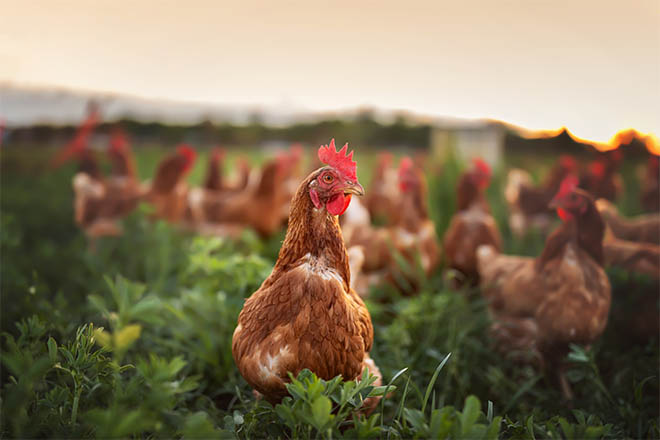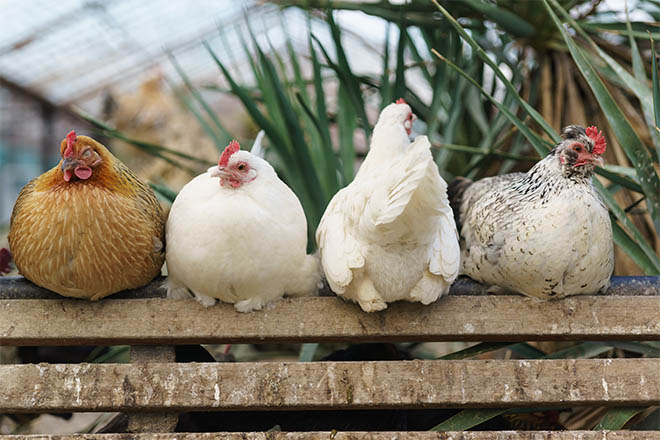Riverina Nutritionist, April 2022
The poultry industry has dramatically changed over the past few decades, with free-range egg farming becoming increasingly popular worldwide.
249 eggs are consumed per person annually [1, 2]. With almost 22 million laying hens across Australia, the uptake of free range farming has presented several challenges to poultry producers. Among these are nutrition-related challenges, which can significantly impact flock welfare and production.
Current poultry management practices are mostly based on research conducted in conventional cage systems, which are impractical for free-range farms. The nutritional requirements of a caged bird are no different to those of a free range bird, however, caged birds have different feeding routines and no access to pasture. Free range farmers have modified existing infrastructure and practices to suit their operations, but this doesn’t always result in optimal production.
Some of the risks free range poultry farmers must consider are:
Gut Impaction
Feather Pecking
Nutrient Dilution
The following article discusses the causes and solutions for each of these problems in free range poultry flocks. For all these issues, the use of scientifically formulated feeds and supplements is a trusted solution to the challenges of free range egg farming. Whether you are a commercial farmer or just keep a few chooks in your backyard, Riverina Stockfeeds offers a range of poultry formulations that supply birds with their complete nutritional requirements. These high quality feeds are an effective way to support the health and productivity of your free range birds.
Gut and Crop Impaction
Free-range hens often consume large amounts of grass, which increases fibre intake and leads to better nutrient utilisation than that of caged hens. The downside of this consumption is that grass may block the gastrointestinal tract, reducing feed intake and nutrient uptake. This impaction has been documented as a significant challenge in free range poultry farming, as it impairs performance, health, and welfare of hens over their lifespan.
For hens grazing on long grass, crop and gut impaction becomes an even more prevalent issue, and can increase mortalities within the flock due to subsequent starvation. A standard brown laying hen must consume a minimum of 105g per hen/day of a nutritionally formulated feed to meet her nutrient requirements [3]. In free range systems, hens may consume approximately 30-40g dry matter/hen/day in the form of grasses without causing impaction or having detrimental production effects. Whereas, it is estimated that hens suffering severe crop impaction may consume up to 60g of fresh grass/hen/day (greater than 60% of total diet), leading to gastrointestinal blockages before feed reaches the gut for further digestion, resulting in death [3].
Aside from crop and gut impaction, high grass intakes lead to nutritional imbalances by diluting the nutritional profile of a commercial formulated layer feed and reducing protein, energy, vitamin and mineral availability, required for peak health and performance.
How do we minimise the risks of gut or crop impaction and over-consumption of pastures?
Feeding a balanced layer ration
Keeping grasses short in foraging areas by mowing regularly [4]
Grazing pastures regularly with cattle, sheep or goats prior to giving access to hens [3]
Closely monitor birds for signs of impaction such as crop enlargement, anorexia and lethargy [4]
Provide an additional source of small, coarse grit particles such as shell grit, calgrit or poultry grit, which can prevent impaction by breaking down grass and feed particles [4]. Free range hens may consume rocks and gritty material in foraging areas, however you can ensure they are getting enough if you add it to their feed ration.
Feather Pecking
Severe feather pecking and lack of optimal housing conditions is another problem that becomes exacerbated in free-range housing systems. Feather pecking has many underlying causes and any single factor can instigate it. However, once it has started in the flock, it becomes almost impossible to eradicate it.
The individual hen exhibiting feather pecking behaviour teaches the learned behaviour to other flock mates, while other birds often imitate the behaviour. This may result in a rapid response, causing feather pecking throughout the whole flock. Severe feather pecking may develop into cannibalism once hens have lost their feathers, predominantly from the back part of the body.
Feather pecking is not only a welfare and health problem, it also has some serious economic implications. Hens suffering from severe feather pecking become submissive and avoid areas of high stocking density. As these areas are often around feeders and waterers, the avoidance results in reduced nutrient intake. Birds may try to hide in higher corners and areas of low bird density where they can avoid being attacked, leading to poor performance. Loss of feather cover of hens in winter or during periods of low temperatures always result in higher feed consumption, as higher energy is required to regulate body temperature. Thus, hens consume higher quantities of feed, but production does not increase, therefore leading to lower profitability or even loss.
Some suggestions to reduce the risk of feather pecking in free range flocks:
Ensure birds are provided with a nutritionally balanced diet, and the feed is kept fresh, dry and free of contamination (feathers, litter etc) at all times
Make sure there is adequate space for all your birds at feeders and watering points, this will prevent competition between birds [5].
Maintain shelter, housing and nesting boxes, ensuring there is plenty of space and protection available for the whole flock.
Provide freely available calgrit, shell grit, or poultry grit.
Purchase pullets from a reputable breeder - this guarantees that your birds have been well raised, with focus on development of their digestive system as young chicks, preventing behavioural issues in their adult life.
Another trick is to put a full bale of lucerne hay in their enclosure - this may stimulate some interest and fulfil their inclination for pecking.
Nutrient Dilution - Feeding Kitchen Scraps
Feeding large quantities of kitchen scraps and other feedstuffs such as meat meal or cracked maize, in addition to a fully balanced feed from a stockfeed company is a common practice among chicken owners.
You may notice when purchasing a formulated layer feed from a stockfeed company that it is labelled as a ‘complete’ feed. This is because the formulation has been designed to fulfil the protein, energy, vitamin and mineral requirements of your birds. Therefore, no additional products need to be fed, aside from a source of grit if recommended by the manufacturer. If additional ingredients such as kitchen waste or other raw materials are fed in conjunction with the layer diet, the total diet of the hens may become nutritionally imbalanced and may not fulfil the hens’ requirements. Key nutrients such as protein and energy may be diluted, resulting in reduced egg production, reduced egg quality and nutritional deficiencies. Kitchen scraps are often high in moisture, low in protein and do not provide balanced nutrition, therefore should only be fed restrictively unless used in a diet formulated by a qualified nutritionist.
Risks of feeding scraps/raw matter:
Mycotoxins: Moulds contaminating aging or poorly stored kitchen scraps or raw materials can produce a range of mycotoxins, and if fed may result in reduced feed intake, wet litter, increase disease risk and reduce egg production and shell quality [6].
Egg Quality: When the overall diet of the hen is nutritionally imbalanced, egg size and production will be influenced. For example, when fed additional meat meal, this may increase overall protein in the diet, thus influencing egg size. Additionally, the extra volume of meat meal fed may reduce the hens’ capacity to eat adequate amounts of their nutritionally balanced commercial feed, resulting in an energy deficiency and subsequently, lowering egg production.
Egg Flavour: When fed to laying hens, some kitchen scraps may change the flavour of the egg. In some cases, onion is known to produce a noticeable aroma and flavour in raw eggs which may be unfavourable to the consumer [7].
Yolk Colour: If kitchen scraps or other raw materials are fed as a large proportion of the total diet and the quantities of scraps vary from day to day there may be variabilities in yolk colour. Carotenoids are naturally occurring pigments found in many fruits, vegetables and plants; they display red, orange and yellow colours which can influence egg yolk colour [8]. If in one week, hens are fed large amounts of carrot waste, and in the following week fed cauliflower waste instead, the egg yolk colour will become paler due to the different levels of pigmentation in the 2 vegetables. If targeting a marketable product with consumer driven preferences for a rich golden yolk colour, this may be detrimental. Commercial stockfeeds are formulated to ensure yolk colour is consistent.
Kitchen scraps including vegetables and fruits can be fed to free range laying hens as a small proportion of the total diet while mindfully avoiding any toxic, mouldy or poor quality ingredients of high variability. While use of these ingredients can be beneficial to reduce food waste and stimulate your hens’ curiosity, some are not suitable for feeding and can be added into compost systems instead. Additional raw materials such as meat meal may influence egg production within your flock.
A nutritionally formulated commercial feed is highly recommended to support health, production and longevity of your laying hens. There are many factors to consider when designing a free range laying system. However, in conjunction with good management procedures, issues such as gut impaction, feather pecking and nutrient dilution can be prevented by feeding a balanced layer feed from Riverina Stockfeeds. Commercial feeds are highly convenient, provide the assurance of balanced nutrition and food safety; while supporting the welfare of your free range birds and supporting optimal egg production.
References
Australian Chicken Meat Federation. Retrieved from www.chicken.org.au/facts-and-figures/ (2022).
Australian Eggs. Retrieved from www.australianeggs.org.au/egg-industry (2021).
Ruhnke, I., Cowling, G., Sommerlad, M., Swick, R., & Choct, M (2014). Gut impaction in free range hens. Conference: Congress of the European Society of Veterinary and Comparative NutritionAt: Utrecht, The Netherlands (18).
Huang, A. S., Carvallo, F. R., Pitesky, M. E., Stoute, S., & Mete, A. (2019). Gastrointestinal impactions in backyard poultry. Journal of Veterinary Diagnostic Investigation, 31(3), 368–370. doi.org/10.1177/1040638719843966
Campbell, D. L. M., Bari, M. S., & Rault, J. L. (2020). Free-range egg production: its implications for hen welfare. Animal Production Science, 61(10), p.853.
Top 10 indicators of mycotoxins in your poultry flock. Alltech. Retrieved from: www.alltech.com/en-gb/blog/top-10-indicators-mycotoxins-your-poultry-flock.
Plagemann, I., Zelena, K., Krings, U., & Berger, R. G. (2011). Volatile flavours in raw egg yolk of hens fed on different diets. Journal of the Science of Food and Agriculture, 91(11), 2061–2065. doi.org/10.1002/jsfa.4420
Carotenoids. Encyclopaedia of Food Chemistry (2019). Retrieved from: www.sciencedirect.com/topics/agricultural-and-biological-sciences/carotenoid








 Beef
Beef
 Dairy
Dairy
 Sheep
Sheep
 Horse
Horse
 Pig
Pig
 Goat
Goat
 Poultry
Poultry
 Bird
Bird
 Dog
Dog
 Special
Special
 Feed Materials
Feed Materials